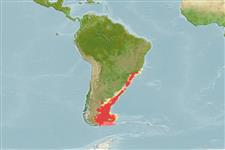Klassifizierung / Names
Namen | Synonyme | Catalog of Fishes (gen., sp.) | ITIS | CoL | WoRMS | Cloffa
Actinopterygii (Strahlenflosser) >
Gadiformes (Cods) >
Merlucciidae (Merluccid hakes) > Merlucciinae
Etymology: Merluccius: Latin, mar, maris = the sea + Latin, lucius = pike (Ref. 45335).
Lebensraum / Klimazone / Range
Ökologie
; seewasser benthopelagisch; ozeanodrom (Ref. 51243); tiefenbereich 50 - 800 m (Ref. 9715), usually 100 - 200 m (Ref. 1371). Temperate; 4°C - 7°C (Ref. 1371), preferred 12°C (Ref. 107945); 20°S - 56°S, 69°W - 40°W (Ref. 58452)
Southwest Atlantic: off southern Brazil to Argentina and the Falkland Islands up to 54°S (Ref. 47377).
Length at first maturity / Size / Gewicht / Alter
Maturity: Lm 31.9 range ? - ? cm
Max length : 95.0 cm TL Männchen/unbestimmt; (Ref. 1371); common length : 50.0 cm TL Männchen/unbestimmt; (Ref. 1371); common length :60 cm TL (female)
Rückenflossenstacheln (insgesamt): 1; Rückenflossenweichstrahlen (insgesamt): 43-52; Afterflossenstacheln 0; Afterflossenweichstrahlen: 36 - 41; Wirbelzahl: 50 - 53. Gill rakers short and thick with blunt tips. Pectoral fins relatively short, not reaching level of anal fin origin. Color is silvery with golden luster on back, silvery white on belly (Ref. 1371).
Adults inhabit continental shelf depths mainly between 100 and 200 m (Ref. 1371). Larger individuals feed on fish (anchovies, hake, nototheniids, myctophids and Southern blue whitings), squids and macrozooplankton (euphausiids and amphipods); smaller individuals feed on mysids and amphipods (Ref. 1371). Migrate inshore during spring and summer, and offshore into deep water wintering areas after spawning; also undertake diel vertical migrations (Ref. 1371). Sold fresh and frozen.
An indeterminate batch spawner.
Cohen, D.M., T. Inada, T. Iwamoto and N. Scialabba, 1990. FAO species catalogue. Vol. 10. Gadiform fishes of the world (Order Gadiformes). An annotated and illustrated catalogue of cods, hakes, grenadiers and other gadiform fishes known to date. FAO Fish. Synop. 125(10). Rome: FAO. 442 p. (Ref. 1371)
IUCN Rote Liste Status (Ref. 115185)
CITES (Ref. 94142)
Not Evaluated
Bedrohung für Menschen
Harmless
Nutzung durch Menschen
Fischereien: hoch kommerziell
Tools
Zusatzinformationen
Download XML
Internet Quellen
Estimates of some properties based on models
Phylogenetic diversity index (Ref.
82805): PD
50 = 0.5000 [Uniqueness, from 0.5 = low to 2.0 = high].
Bayesian length-weight: a=0.00525 (0.00424 - 0.00650), b=3.06 (3.01 - 3.11), in cm Total Length, based on LWR estimates for this species (Ref.
93245).
Trophic Level (Ref.
69278): 4.2 ±0.67 se; Based on food items.
Widerstandsfähigkeit (Ref.
69278): niedrig, Verdopplung der Population dauert 4,5 - 14 Jahre. (K=0.13-0.19; tm=6).
Prior r = 0.35, 2 SD range = 0.15 - 0.80, log(r) = -1.05, SD log(r) = 0.42, Based on: 5 K, 1 tgen, 1 Fec records
Verwundbarkeit (Ref.
59153): High vulnerability (58 of 100) .
